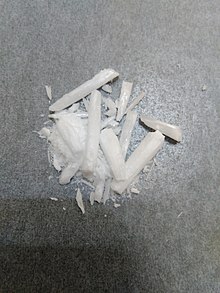
Back Seleendioksied Afrikaans ثنائي أكسيد السيلينيوم Arabic سلنیوم دیاوکسید AZB Oxid seleničitý Czech Selendioxid German Dióxido de selenio Spanish سلنیوم دیاکسید Persian Seleenidioksidi Finnish Dioxyde de sélénium French सेलेनियम डाइऑक्साइड Hindi
 | |
 | |
 | |
| Names | |
|---|---|
| Other names
Selenium(IV) oxide
Selenous anhydride | |
| Identifiers | |
3D model (JSmol)
|
|
| ChEMBL | |
| ChemSpider | |
| ECHA InfoCard | 100.028.358 |
| EC Number |
|
PubChem CID
|
|
| RTECS number |
|
| UNII | |
| UN number | 3283 |
CompTox Dashboard (EPA)
|
|
| |
| |
| Properties | |
| SeO2 | |
| Molar mass | 110.96 g/mol |
| Appearance | White crystals, turn slightly pink with trace decomposition[1] |
| Odor | rotten radishes |
| Density | 3.954 g/cm3, solid |
| Melting point | 340 °C (644 °F; 613 K) (sealed tube) |
| Boiling point | 350 °C (662 °F; 623 K) subl. |
| 38.4 g/100 mL (20 °C) 39.5 g/100 ml (25 °C) 82.5 g/100 mL (65 °C) | |
| Solubility | soluble in benzene |
| Solubility in ethanol | 6.7 g/100 mL (15 °C) |
| Solubility in acetone | 4.4 g/100 mL (15 °C) |
| Solubility in acetic acid | 1.11 g/100 mL (14 °C) |
| Solubility in methanol | 10.16 g/100 mL (12 °C) |
| Vapor pressure | 1.65 kPa (70 °C) |
| Acidity (pKa) | 2.62; 8.32 |
| −27.2·10−6 cm3/mol | |
Refractive index (nD)
|
> 1.76 |
| Structure | |
| see text | |
| trigonal (Se) | |
| Hazards | |
| Occupational safety and health (OHS/OSH): | |
Main hazards
|
Toxic by ingestion and inhalation[2] |
| GHS labelling: | |
  
| |
| Danger | |
| H301, H331, H373, H410 | |
| P260, P261, P264, P270, P271, P273, P301+P310, P304+P340, P311, P314, P321, P330, P391, P403+P233, P405, P501 | |
| NFPA 704 (fire diamond) | |
| Flash point | Non-flammable |
| Lethal dose or concentration (LD, LC): | |
LCLo (lowest published)
|
5890 mg/m3 (rabbit, 20 min) 6590 mg/m3 (goat, 10 min) 6590 mg/m3 (sheep, 10 min)[3] |
| Safety data sheet (SDS) | ICSC 0946 |
| Related compounds | |
Other anions
|
Selenium disulfide |
Other cations
|
Ozone Sulfur dioxide Tellurium dioxide |
| Selenium trioxide | |
Related compounds
|
Selenous acid |
Except where otherwise noted, data are given for materials in their standard state (at 25 °C [77 °F], 100 kPa).
| |
Selenium dioxide is the chemical compound with the formula SeO2. This colorless solid is one of the most frequently encountered compounds of selenium. It is used in making specialized glasses as well as a reagent in organic chemistry.[4]
- ^ "Safety data sheet: Selenium dioxide" (PDF). integrachem.com. 27 March 2015. Retrieved 2022-12-02.
- ^ "Selenium dioxide safety and hazards". pubchem.ncbi.nlm.nih.gov. Retrieved 2022-12-02.
- ^ "Selenium compounds (as Se)". Immediately Dangerous to Life or Health Concentrations (IDLH). National Institute for Occupational Safety and Health (NIOSH).
- ^ Hoekstra, William J.; Fairlamb, Ian J. S.; Giroux, Simon; Chen, Yuzhong (2017). "Selenium(IV) Oxide". Encyclopedia of Reagents for Organic Synthesis. pp. 1–12. doi:10.1002/047084289X.rs008.pub3. ISBN 978-0-470-84289-8.
